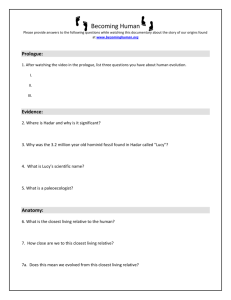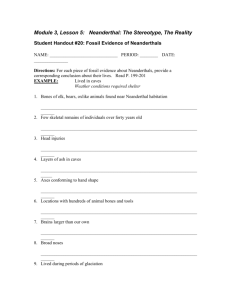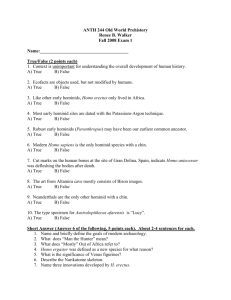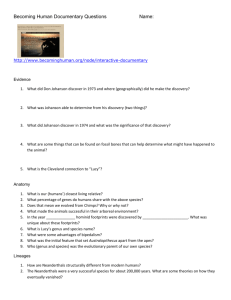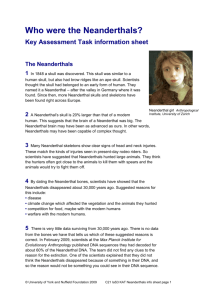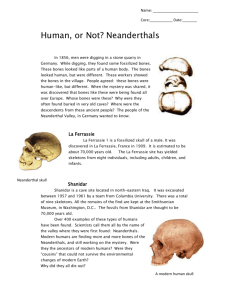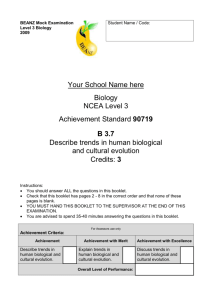Early Man
advertisement
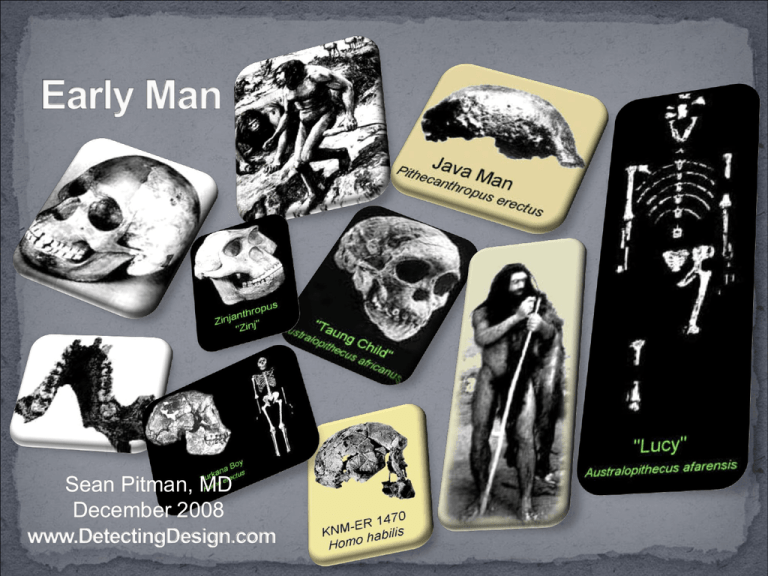
Sean Pitman, MD December 2008 Earnest A. Hooten, Harvard professor of Anthropology, “Reconstructions?” Up from the Ape, pp. 332 William W. Howells, Harvard professor of Anthropology, Mankind so Far, pp. 138 Eanthropus dawsoni or “Dawn Man” “Discovered” by Charles Dawson in 1912 (an ape-like mandible with human-like teeth and a human-like piece of skull) In 1953 Oakley, Weiner and Clark exposed Piltdown Man as a deliberate hoax Interesting because this rather obvious hoax was accepted by the scientific community as real evidence of human-ape ancestry for over 40 years Hesperopithecus haroldcookii Mr. Harold Cook discovered one tooth in 1922 in the Pliocene deposits of Nebraska An attempt was made to use Nebraska Man as evidence in the Scopes “Monkey Trial” Drawing published in Illustrated London News, 1922 American Museum of Natural History Wolf J. and Mellett J.S., The role of "Nebraska man" in the creationevolution debate. Creation/Evolution, Issue 16:31-43., 1985 London Daily News, 1922 Little did Osborn know Just how inaccurate this drawing was Turned out to be a tooth from an extinct type of pig (peccary) I wonder how the history would remember the Scopes trial if this little bit of information had become available during the trial? Pithecanthropus erectus Found by Eugene Dubois between 1891 and 1892 Association of a human-like femur with a very large gibbon-like skullcap, found 12 meters apart The false association was eventually recognized and Java Man was removed from the American Museum of Natural History and the Leiden Museum (1980s) Sort of . . . Evolutionary Sequence from ape to human In 1932 Louis Leaky discovered a fragmented maxilla and some teeth in southwest Kenya Assembled to form a parabolic shape similar to the human condition Presented as the first branch of ape to evolve into humans 12 to 14 million years ago Problem: A full jaw (mandible) was discovered In 1977 a full Ramapithecus jaw bone was discovered but was U-shaped Zilman and Lowenstein attempt to explain the reason for the earlier thinking of most of the worlds most prominent paleoanthropologists: “Ramapithecus walking upright has been reconstructed from only jaws and teeth. In 1961 an ancestral human was badly wanted. The prince's ape latched onto position by his teeth and has been hanging on ever since, his legitimacy sanctified by millions of textbooks and Time-Life volumes on human evolution.” Evolution of Ramapithecus Gorilla Skull Discovered in 1974 by Donald Johanson Angle of knee joint matched that of humans The joint angle also matched that of tree climbing apes Also had curved toes bones, high arm to leg length ratio, and many other features identical to tree climbing apes Was Lucy just a tree climbing ape or did she walk upright? Stern and Susman detail many features consistent with tree-climbing apes for A. afarensis Yet, they believe that A. afarensis spent much time running around on two legs? Why? “The most significant features for bipedalism include shortened iliac blades, lumbar curve, knees approaching midline, distal articular surface of tibia nearly perpendicular to the shaft, robust metatarsal I with expanded head, convergent hallux (big toe), and proximal foot phalanges with dorsally oriented proximal articular surfaces.” (McHenry 1994) The perpendicular tibia, lumbar curve, and angled knee joints that are "approaching midline" are seen in modern tree-climbing monkeys The "robust" first metatarsal with an expanded head is also consistent with Stern and Susman's comment that the hand bones (and reasonably the foot bones as well), "have large heads and bases relative to their parallel sided and somewhat curved shafts, an overall pattern shared by chimpanzees" and that this, "might be interpreted as evidence of developed grasping capabilities to be used in suspensory behavior." 3.6 million year old footprints with modern human features, adult and child Happen to be about as old as Lucy How can Lucy be a “missing link” if modern human posture and gait were already evolved? “As I kneel beside the large print and lightly touch its sole, I am filled with quiet awe. It looks perfectly modern. ‘I thought that at three and a half million years ago their prints might be somehow different from ours,’” says Latimer. “But they aren’t. The bipedal adaptation of those hominids was full-blown.” Gore, R. National Geographic, Feb. 1997 Johanson insisted strongly that the Laetoli footprints simply would have to have been made by his A. afarensis (i.e. Lucy): “The foot prints would have to be from A. afarensis. They substantiate our idea that bipedalism occurred very early, and our contention that the brain was too small to master tools.” Problem: The foot bones and lower leg of A. africanus (Lucy) have been recently found (in Hadar) These foot and leg bones are apelike KNMER1470 found in 1972 with a modern human femur More human-like skull than Lucy Ash atop 1470 originally dated (1969) by K-Ar at ~220 Ma by multiple labs This dating done before 1470 found After 1470 found ash redated over and over again until the “best” date was placed at 2.61 Ma Lucy originally dated at 2.9 Ma KNMER 1470 re-dated using Basil Cook’s pig teeth sequences to less than 2 Ma and Lucy to more than 3 Ma Richard Leakey, June of 1973, in an interview with National Geographic: "Either we toss out the 1470 skull or we toss out all our theories of early man. It simply fits no previous models of human beginnings. 1470 leaves in ruin the notion that all early fossils can be arranged in an orderly sequence of evolutionary changes." Discovered in 1959 by Mary Leakey Found with stone tools and evidence of “butchered” animals Given name of “Handy Man” or Homo habilis – supposedly evolved after/from Lucy (Australopithecines) Does Zinj look at all like KNMER 1470? (Both are Homo habilis) Fossil and living Coelacanths that were given different genus and species names yet look far more similar than Zinj and KNM-ER 1470 discussed in lecture on the Fossil Record Dr. Spoor’s research on semicircular canals of H. erectus, Australopithecus, and many other hominids indicates that H. habilis, "relied less on bipedal behavior than the australopithecines." And yet, H. Habilis is supposed to be more advanced than australopithecines? Leakey, 1990 PBS documentary: “If pressed about man's ancestry, I would have to unequivocally say that all we have is a huge question mark. To date, there has been nothing found to truthfully purport as a transitional specie to man, including Lucy, since 1470 was as old and probably older. If further pressed, I would have to state that there is more evidence to suggest an abrupt arrival of man rather than a gradual process of evolving.” Matt Cartmill, Duke; David Pilbeam, Harvard; Glynn Isaac, Harvard, American Scientist, July-August 1986, p.419 Neandertal (Neanderthal) Man (Homo neanderthalensis) Thought to have died out over 20,000 years ago. First found in 1856 in Neander Valley, Germany Johann Fahlrott (a school teacher) Dozens of skeletons have since been found In 1908, Professor Boule of The Institute of Human Paleontology in Paris declared Neanderthal an ape-man because of his low eyebrow ridges and the stooped over posture of some of the specimens Neanderthals had bigger brains (>200cc) Lived a long time (stooped by osteoarthritis) Dr. Rudolph Virchow argued in 1872 that Neanderthals were modern humans with rickets and arthritis The Chicago Field Museum has since put in a newer exhibition of Neanderthal man looking more fully human What’s the latest “scientific” explanation? Neanderthal man was an “evolutionary dead-end” What about DNA? July 11, 1997, Neanderthal mitochondrial DNA (mtDNA) successfully recovered and sequenced by Svante Pääbo et. al. (Cell) mtDNA recovered three times Pääbo’s Conclusion: Evolutionary divergence from modern humans some 550,000 to 690,000 years ago Max difference between human and human: Ave. Human Difference: 8 ± 3.0 Intra-Human Range: 1 – 35 differences (1999) Ave. Human-Neandertal Difference: 25.6 ± 2.2 Human-Neandertal Range: 20 – 34 Ave. Human-Chimp Difference: 55.0 ± 3.0 Human-Chimp Range: 46-67 Intra-Chimp Range: (1-81) Overlaps between humans and Neandertals Might be 35 differences from the guy sitting next to you and only 20 differences from a Neandertal A human-chimp “relationship” might be closer than a chimp-chimp “relationship” Human-chimp difference might be only 46 while a chimp might be 81 differences from another chimp Further confusion from Pääbo’s article: Neanderthal mtDNA was actually farther away from chimp mtDNA than that of modern humans We “modern” humans are therefore more chimp-like than Neanderthals?! Or, within the range of ethnic variation? mtDNA as a Molecular Clock: Recently called into question by articles in several well-known journals like Science Clock off by as much as “20-fold” Mitochondrial Eve, once thought to be 100,000 to 200,000 years old, might now have to be revised to as young as “6,000 years old” (Parsons et al) A more recent 2007 study: “Comparisons suggest large differences: the mutation rate estimated from pedigrees of humans is a hundredfold higher than the substitution rate for the primate mitochondrial DNA control region. . . We await the more rigorous type of assessment with some nervousness, given that we suspect they might reveal that many past studies placed too much confidence in simple molecular clock analyses, and that their conclusions should thus be revisited.” Mario J.F. Pulquerio and Richard A. Nichols, Dates from the molecular clock: how wrong can we be? Science Direct, Trends in Ecology and Evolution, Vol. 22, No. 4, 2007 A mathematical model: “These analyses suggest that the genealogies of all living humans overlap in remarkable ways in the recent past. In particular, the MRCA of all present-day humans lived just a few thousand years ago [~3-4000 B.C.] in these models. Moreover, among all individuals living more than just a few thousand years earlier than the MRCA, each present-day human has exactly the same set of genealogical ancestors.” Douglas L. T. Rohde, Steve Olson & Joseph T. Chang, Modeling the recent common ancestry of all living humans, Nature 431, Accepted 14, July 2004 In 1937, Germaine Henri- Martin, a very well respected archeologist, began excavations in a cave in southwestern France called Fontéchevade and continued her work here until 1954, removing over 900 cubic meters of sediment Discovered “first Frenchmen” older than Neanderthals Many layers found The topmost layers: "Aurignacian" (modern) Underneath the Aurignacian: "Mousterian" layers, laid down during the time of the Neandertals Below the Mousterian: "Tayacian" layers within which she found several human skull fragments and evidence for the living conditions of these “first Frenchmen” Germaine found lots of evidence of how the first Frenchmen lived The site is full of flint, which was interpreted as being worked into tools Various "hearths" were also found throughout the site where the first families cooked, prepared their food, and ate Evidence of meals, in the form of animal bones, were everywhere Bones of the hominids themselves The evidence for a rather complete an intricate life for the earliest French people seemed rather obvious and fairly easily interpreted In the 1970s Shannon McPherron and Harold Dibble decided to do some reinvestigation Laser mapped of thousands of stone objects and bones Everything in the cave was oriented horizontally or vertically with respect to the cave walls and there was evidence of water sorting The stone “tools” turned out to be no different than naturally carved stones Source of water found – an opening at the back of the cave that drained water and sediments from above The narrator of the 2002 PBS documentary, "Neanderthals on Trial" concluded: “What made it look real to the archaeologists was an overwhelming desire to see the past in a certain way. The urge to distance ourselves from Neanderthals or to pull them closer to us is a surprisingly powerful force. Archaeologists Jean Philippe Rigaud and Jan Simek are well aware of the problem." [Jan Simek added], "I think that we're as guilty of it today, of that kind of preconceived approach to our data, as anybody has been in the history of archaeology or anthropology. It's almost inevitable that our own views of the world will be brought to bear. . . . . . So it appears that Fontéchevade was an elaborate illusion and not a human habitation site at all. What made it look real to the archeologists was an overwhelming desire to see the past in a certain way” It is also interesting to consider comments made by the journalist, Mark Davis, who investigated this story on Neanderthals for NOVA. "I spoke with many Neanderthal experts in the course of making this film, and I found them all to be intelligent, friendly, welleducated people, dedicated to the highest principles of scientific inquiry. I also got the impression that each one thought the last one I talked to was an idiot, if not an actual Neanderthal. . . The more people I spoke with, the more confusing it got. . . Listening to the archeologists and anthropologists talk about their work (and their colleagues' work), I heard the same frustrations voiced again and again: People are driven by their preconceptions. They see what they want to see. They find what they're looking for. . . . . . I learned that what people see in Neanderthals often has as much to do with philosophy as it does with science. What does it mean to be human? Some definitions are broad and inclusive, others are narrow and exclusive. Scholars have been known to attack one another's views on Neanderthals as "racist" or "politically correct." . . . What I found most interesting in all this is that every scientist I talked to encouraged me to explore the issue of self-delusion, and no one claimed to be immune. They are all aware that the history of the field is littered with brilliant scholars who completely missed the boat because of the power of their preconceptions." "A five million-year-old piece of bone that was thought to be a collarbone of a humanlike creature is actually part of a dolphin rib... The problem with a lot of anthropologists is that they want so much to find a hominid that any scrap of bone becomes a hominid bone." - Dr. Tim White (anthropologist, University of California, Berkeley). As quoted by Ian Anderson "Hominoid collarbone exposed as dolphin's rib", in New Scientist, 28 April 1983, p. 199 3 feet tall with brain the size of a grapefruit - Bones discovered in a cave on Flores (Indonesian island) in 2003 Homo floresiensis Claimed to be a new “species” of human due to unique features of the skull and a chimp-like wrist bone compared to modern humans The excavation work was partially funded by the National Geographic Society, which premiered a film about the work March 10, 2008 Days later Lee Berger (U. of Witwatersrand in Johannesburg) published a find of least 26 other individuals of similar size in caves on Microneasian islands. “Islands overrun by diminutive humans as recently as 1,400 years ago - but despite their size these people clearly belonged to our species.” - i.e., modern pygmies As far as the chimp-like wrist bones, modern humans can have a mutated gene (PCNT) that produces 3-4 ft stature, proportionate body size with normal or near normal intelligence… and bony wrist anomalies. http://www.newscientist.com/article/dn13441-new-bones-suggest-hobbits-were-modern-pygmies.html?feedId=online-news_rss20 http://www.telegraph.co.uk/scienceandtechnology/science/sciencenews/3320502/%27Hobbits%27-not-a-different-species,-say-scientists.html "The question that I and my colleagues have asked ourselves is how anyone could possibly believe this, [that the hobbits are a new species of hominids and not simply a modern ethnic human variation]. There was such a will to believe in the story that critical faculties were suspended on the part of many people.” Robert Eckardt at Pennsylvania State University, who co- authored the critique of the hobbit theory in the Proceedings of the National Academy of Sciences. http://www.guardian.co.uk/science/2006/aug/22/uknews F. Spoor, M. G. Leakey, P. N. Gathogo, F. H. Brown, S. C. Antón, I. McDougall, C. Kiarie, F. K. Manthi & L. N. Leake, Implications of new early Homo fossils from Ileret, east of Lake Turkana, Kenya, Nature, Vol. 448 (7154), pp. 688 (August 9, 2007) Notice that it is ok to put this or that aspect of the theory of evolution to the test as long as the overall theory itself is “not questioned” or subject to potential falsification. F. Spoor, M. G. Leakey, P. N. Gathogo, F. H. Brown, S. C. Antón, I. McDougall, C. Kiarie, F. K. Manthi & L. N. Leake, Implications of new early Homo fossils from Ileret, east of Lake Turkana, Kenya, Nature, Vol. 448 (7154), pp. 688 (August 9, 2007) Humans, rats, and rice plants: Same number of genes The key: Non-coding DNA formerly known as “Junk DNA” Examples: microRNAs, Pyknons and pseudogenes “‘Indeed, what was damned as junk because it was not understood may, in fact, turn out to be the very basis of human complexity,’” Mattick suggests. “Pseudogenes, riboswitches and all the rest aside, there is a good reason to suspect that is true. Active RNA, it is now coming out, helps to control the large-scale structure of the chromosomes and some crucial chemical modifications to them—an entirely different, epigenetic layer of information in the genome.” Wyatt Gibbs, “The Unseen Genome: Gems among the Junk”, Scientific American, November 2003, pp 45-53 “The different miRNA repertoire, as well as differences in expression levels of conserved miRNAs, may contribute to gene expression differences observed in human and chimpanzee brain. . . For example, miRNAs recently have been implicated in synaptic development and in memory formation. As the species specific miRNAs described here are expressed in the brain, which is the most complex tissue in the human body, with an estimated 10,000 different cell types, these miRNAs could have a role in establishing or maintaining cellular diversity and could thereby contribute to the differences in human and chimpanzee brain… function.” Berezikov et. al., Nature Genetics 2006 Oliver Originally captured in the 1960s from the African Congo. Thought, even by scientists, to be a possible humanchimp hybrid. “My reservations concern not so much this book but the whole subject and methodology of paleoanthropology. But introductory books - or book reviews - are hardly the place to argue that perhaps generations of students of human evolution, including myself, have been flailing about in the dark: that our data base is too sparse, too slippery, for it to be able to mold our theories. Rather the theories are more statements about us and ideology than about the past. Paleoanthropology reveals more about how humans view themselves than it does about how humans came about. But that is heresy.” Dr. David Pilbeam, an anthropologist from Harvard, making some very interesting comments in a 1978 review of Richard Leakey's book, Origins DetectingDesign.com
